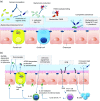Can probiotics modulate human disease by impacting intestinal barrier function?
- PMID: 28102115
- PMCID: PMC5297585
- DOI: 10.1017/S0007114516004037
Can probiotics modulate human disease by impacting intestinal barrier function?
Abstract
Intestinal barrier integrity is a prerequisite for homeostasis of mucosal function, which is balanced to maximise absorptive capacity, while maintaining efficient defensive reactions against chemical and microbial challenges. Evidence is mounting that disruption of epithelial barrier integrity is one of the major aetiological factors associated with several gastrointestinal diseases, including infection by pathogens, obesity and diabetes, necrotising enterocolitis, irritable bowel syndrome and inflammatory bowel disease. The notion that specific probiotic bacterial strains can affect barrier integrity fuelled research in which in vitro cell lines, animal models and clinical trials are used to assess whether probiotics can revert the diseased state back to homeostasis and health. This review catalogues and categorises the lines of evidence available in literature for the role of probiotics in epithelial integrity and, consequently, their beneficial effect for the reduction of gastrointestinal disease symptoms.
Keywords: CD Crohn’s disease; NEC necrotising enterocolitis; TJ tight junction; TLR Toll-like receptor; UC ulcerative colitis; Gastrointestinal disorders; Gut barrier; Gut microbiota; Immunity; Probiotics.
Figures

References
-
- Claes IJJ, Garcia CEV & Lebeer S (2015) Novel opportunities for the exploitation of host-microbiome interactions in the intestine. Curr Opin Biotechnol 32, 28–34. - PubMed
-
- van Baarlen P, Kleerebezem M & Wells JM (2013) Omics approaches to study host-microbiota interactions. Curr Opin Microbiol 16, 270–277. - PubMed
-
- Bron PA, van Baarlen P & Kleerebezem M (2012) Emerging molecular insights into the interaction between probiotics and the host intestinal mucosa. Nat Rev Microbiol 10, 66–78. - PubMed
-
- Cani PD (2014) Metabolism in 2013: the gut microbiota manages host metabolism. Nat Rev Endocrinol 10, 74–76. - PubMed
-
- Hill C, Guarner F, Reid G, et al. (2014) Expert consensus document: The International Scientific Association for Probiotics and Prebiotics consensus statement on the scope and appropriate use of the term probiotic. Nat Rev Gastroenterol Hepatol 11, 506–514. - PubMed
Publication types
MeSH terms
LinkOut - more resources
Full Text Sources
Other Literature Sources
Medical

